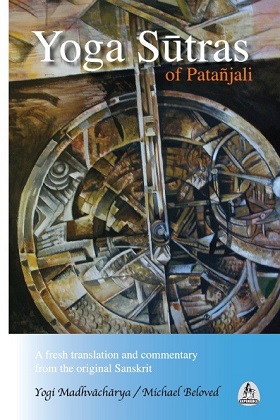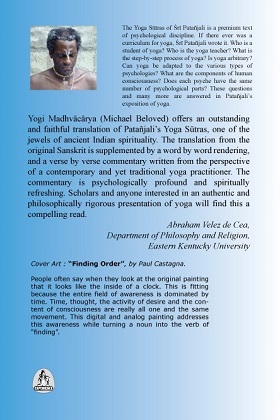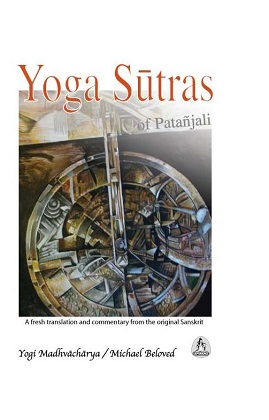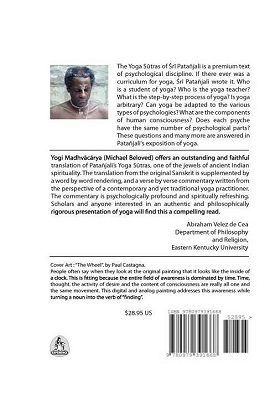Paperback Cover


Hardbound Cover


Publication Data
Publisher: Michael Beloved
Date: April 28, 2008
ISBN Print (paperback): 9780979391613
ISBN Print (hardbound): 9780979391668
ISBN eBook: 9780979391682
LCCN (paperback): 2010918321
LCCN (hardbound): 2008906317
Pages: 294
Illustrations: 2
Trim Size: 9 x 6 x 0.7 inches
Language: English
Category: Religion & Spirituality
Book Vendors
Bookwire/Bowker ISBN Agency (SEO): Paperbook / eBook/ Hardbound
Paperback
|
Amazon |
|
| Barnes & Nobles | USA |
Hardbound
Amazon Lulu
eBooks
| Kindle | |
| Nook | USA |
| Kobo | USA/Canada Japan |
| iTunes | Global |
Email:
Forum: inSelf Yoga
Description:
A fresh translation of Yoga Sutras of Patanjali, with word-for-word meanings and precise commentary. New insight into the advanced practices of meditation, kriya yoga and raja yoga. - A gift from a great yogin -
Back Cover:
The Yoga Sūtras of Śrī Patañjali is a premium text of psychological discipline. If there ever was a curriculum for yoga, Śrī Patañjali wrote it. Who is a student of yoga? Who is the yoga teacher? What is the step-by-step process of yoga? Is yoga arbitrary? Can yoga be adapted to the various types of psychologies? What are the components of human consciousness? Does each psyche have the same number of psychological parts? These questions and many more are answered in Patañjali’s exposition of yoga.
Author's Comment:
I recommend a detailed study of Sri Patanjali Maharshi's Yoga Sutras. His lay out is the curriculum for yoga. It is classic and final. Nobody can improve it. At first this book might seem difficult reading but if you are patience, you will get much insight about Yoga
Reviews:
By Abraham Velez de Cea, Department of Philosophy and Religion, Eastern Kentucky University:
Yogi Madhvacharya (Michael Beloved) offers an outstanding and faithful translation of Patañjali's Yoga Sutras, one of the jewels of ancient Indian spirituality. The translation from the original Sanskrit is supplemented by a word by word rendering, and a verse by verse commentary written from the perspective of a contemporary and yet traditional yoga practitioner. The commentary is psychologically profound and spiritually refreshing. Scholars and anyone interested in an authentic and philosophically rigorous presentation of yoga will find this a compelling read.
By Marcia Metusalem:
Serious students of yoga and meditation will find this book intellectually and spiritually stimulating. The translation stays true to the Sanskrit and is terse, leaving little room for speculation. Part 2, the “approach” to the Sutras, gives needed relief to readers who might grasp the translation but nevertheless have difficulty integrating Patanjali’s in depth analysis of the yoga process. Some readers may find it easier to begin at Part 2 and then go on to Parts 1 and 3. The commentaries contain useful information and explanations relating to the Sutras and also give a unique perspective based on the writer’s own yoga practice. A persistent reader will not be disappointed for between the lines one finds the faith, inspiration and encouragement to try for success in yoga.
By Neil Crenshaw (Amazon customer review):
This is the best book that I've been able to find on the Yoga Sutras and I have reviewed several on the subject. The Yoga Sutras of Patanjali by Michael Beloved is very easy and enjoyable to read. Michael Beloved divides his book into three parts: 1) the Sanskrit text of Patanjali with Michael's translation, 2) a brief explanation of what each verse means, in English and 3) a simple translation and commentary on each chapter and verse.
The third part of the book is where I spent most of my time. This part has Patanjali's actual Sanskrit words with Michael's translation of those words and then Michale's commentary about Patanjali's work and meaning for that particular topic. The commentary gave me a better understanding of what Patanjali was trying to convey. The three parts can be read separately or at the same time. I prefered reading the three parts together. I put a paper clip on the first page of each chapter and flipped back-and-forth from one part to the other, reading one verse at a time as I went along. This gave me greater understanding, insight and appreciation for Patanjali's work. This book is a work of art. I highly recommend this book to anyone interested in yoga, ancient texts of the eastern world or spirituality.
